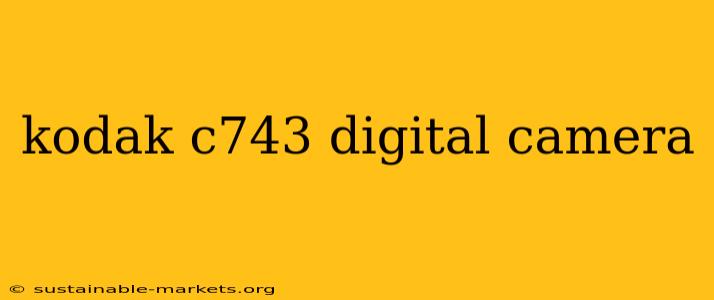The Kodak EasyShare C743, while no longer in production, holds a special place in the hearts of many digital photography enthusiasts. This review explores its features, strengths, weaknesses, and its surprising continued relevance in today's digital landscape. We'll delve into why some still cherish this compact camera and what it offers that modern devices often lack.
A Look Back at the Kodak C743
Released in the mid-2000s, the Kodak EasyShare C743 represented a significant leap in point-and-shoot technology for its time. It boasted a respectable 7.1-megapixel sensor, a 3x optical zoom lens, and Kodak's signature user-friendly interface. Its compact design made it ideal for everyday snapshots and travel photography, appealing to a broad audience seeking simplicity and convenience. Key features included:
- 7.1 Megapixel Sensor: While seemingly low by today's standards, this resolution was quite impressive back then, producing images suitable for printing at reasonable sizes.
- 3x Optical Zoom: Allowed for decent versatility in capturing subjects both near and far, enhancing its usability in diverse shooting scenarios.
- EasyShare Technology: Seamless integration with Kodak's EasyShare software facilitated easy image transfer and management on computers, streamlining the post-processing workflow.
- Compact and Lightweight Design: The portability was a major selling point, making it perfect for casual photographers who didn't want to carry bulky equipment.
Strengths of the Kodak C743 in a Modern Context
While newer cameras offer superior specifications, the C743 still holds some advantages:
- Simplicity: In an era dominated by complex camera settings and menus, the C743's straightforward interface stands out. It’s perfect for beginners or those who simply want to point and shoot without technical hassles.
- Nostalgia: For many, the C743 evokes a sense of nostalgia, reminding them of simpler times and cherished memories captured with the device. The familiar Kodak brand name itself carries a certain weight of photographic heritage.
- Film-like Quality (to a degree): While not a true film camera, the C743's sensor and processing often produced images with a slightly softer, less-processed look than many modern cameras, which some find aesthetically pleasing. This "Kodak moment" is hard to replicate with today's heavily processed images.
- Affordability: Being a discontinued model, the Kodak C743 is readily available secondhand at remarkably low prices. This makes it an excellent entry point into digital photography or a fun addition to a collection.
Weaknesses of the Kodak C743
It's important to acknowledge the limitations of this older model:
- Low-Light Performance: The sensor struggled significantly in low-light conditions, resulting in grainy and noisy images.
- Limited Features: Compared to modern cameras, the C743 lacks advanced features such as manual controls, RAW shooting capabilities, and high-resolution video recording.
- Technological Limitations: The image processing capabilities are far behind modern standards, resulting in images that might appear less sharp or detailed compared to contemporary devices.
Conclusion: The Enduring Appeal of the Kodak C743
The Kodak EasyShare C743 might not be the cutting-edge technology of today, but its simplicity, affordability, and nostalgic appeal continue to resonate. It's a testament to the fact that sometimes, the best camera is the one you have with you, especially when simplicity and ease of use are paramount. For those seeking a simple, affordable way into the world of digital photography, or for those seeking a nostalgic connection to a simpler photographic past, the C743 may well be a worthwhile option. Its limitations are evident, but its strengths remain relevant in certain contexts.

